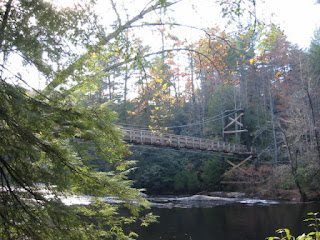(This is Part 2 of a two-part blog series on the Benton MacKaye Trail with guest blogger "Sgt Rock"). Click Part 1 for the first part in this series.
I’m often asked why hike the Benton MacKaye Trail (BMT) or what is the difference between the AT and the BMT.
Let me try and expand on that for y’all.
Often I get asked “it is blazed just like the Appalachian Trail (AT) right?” No it isn’t. Sometimes I get asked “Are there shelter regularly, just like the AT? I prefer to stay in shelters.” Sorry there are only two shelters. Sometimes this dissuades people from hiking the BMT, but the BMTA is OK with this. I liken it to the movie “Demolition Man” which was about a dystopian future and in that world all restaurants had been taken over by Taco Bell®, so the only thing you got, where ever you went to eat, was Taco Bell® food. Well we want to give hikers that are looking for something different from the AT experience, something different to go for. It would be a shame if all trails were just like the AT.
As I mentioned in my earlier post, the BMT passes through numerous wilderness areas or in areas that are managed as wilderness such as wilderness study areas and the Great Smoky Mountain National Park which does some if its land management like a wilderness area but is not an established “wilderness area” as designated by the federal government. With that in mind, you will find that the BMT is often “wilder” than the AT with the trail often only a narrow strip through fields and woods with minimal marking, where the AT in similar surroundings could be 3’ wide, rutted, and have posts sticking out of the ground every few hundred feet with a white blaze on it just in case you couldn’t figure out it was a trail. The BMT also has less trail structures like bridges, shelters, signs to tell you where you are at or where the water is, etc. Don’t get me wrong, we do have some of these, but you might find one sign pointing to water in 100 miles, or miles of trail with water crossings and no bridges, and we average about one shelter for every 143 miles give or take. Why is it like this? Because that is the way it was envisioned by the original designers. Because the trail passes through true designated “wilderness areas” trail maintenance is a lot harder for the maintainers, often you will find blow downs or some brush that could use some work, but nothing really blocks the trail. It is a part of experiencing wilderness as it really is sometimes.
So that leads to the next point: why hike the BMT?
Generally I would say the easy answer is for solitude and the wilderness experience. How many of us have been hiking the AT, get the feeling we are miles from the rest of humanity, and then night falls and someone’s porch light turns on a half mile from you? The BMT passes through some designated wildernesses where you can set up camp, and when night falls - you might see the light from distant small town miles away, glowing from behind a mountain on the horizon and you really are miles from the rest of humanity.
And besides being away from everyone else in the civilized world, the trail is basically away from even the hiker world. If you are into the social scene of the trail, or you need to be around people every night when camping, you better go with a group on the BMT because if you don’t, you are likely to not see anyone for days. And when I say “not see anyone” I am not just talking about hikers. There is a good chance you can go for days and not see another human being. Most hikers tell me that they see about 10 people in the first 6 miles of the trail (where the AT and BMT crisscross four times) and then see less than 10 for the next 280 miles.
So all that said, I am sure a few of you have decided that the BMT is not for you. That's okay. Some day it might be just what you are looking for. We find that many of our thru-hikers are former AT thru-hikers that want something long to hike and a little challenging, but one that doesn’t take 6 months to complete. We do get the adventurous soles that are also looking for something different from the “drama” and crowds that the AT can be at the beginning of the AT thru-hiking season and use the BMT to start their long hike and skip from Springer to the Smokies without having to deal with all that. We also get people in the park that take the BMT as an alternate route in order to avoid crowded mouse filled shelters and have the freedom of 19 (mostly empty) campsites to choose from over 13 shelters on the most traveled trail in the most used national park in America.
I hope to see some of you out there!



1 comment:
It sounds more like the BMT is like most wilderness trails and its the AT that is so different.
Though I'm heading out to thru-hike the AT soon, I'm still trying to get my head around the idea of wanting to artificially limit my daily hiking distance inorder to stay in a 3-sided shelter crowded beyond capacity with strangers who snore with mice running over my head. The BMT sounds like a normal backpacking trip to me. I'll definitely check it out one of these days.
Post a Comment